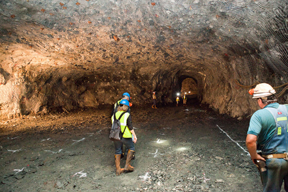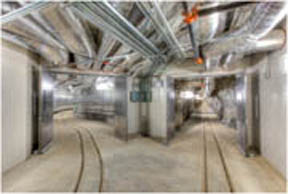Science Unearthed
By Autumn Cafiero Giusti

Tackling any complex, multimillion-dollar construction project is bound to come with challenges. But completing an entire project 4,850 feet underground introduces a whole new dynamic.
This was the feat Ainsworth-Benning Construction Inc. had to accomplish to transform a former gold mine into a world-class underground national laboratory.
The contractor won an $8.1-million contract to outfit the 30,000-sq-ft Davis Campus at the Sanford Underground Research Facility, the site of the former Homestake Underground Gold Mine in Lead, S.D.
Given the project’s complexity, Ainsworth-Benning received a 2013 Alliant Build America Award for the category of Building under $10 Million New for the Davis Campus project. A member of the AGC of South Dakota and the South Dakota Building Chapter, Ainsworth-Benning has operated for more than 55 years.
The most significant challenge to the construction team was that no one had ever bid, managed or constructed a project a mile underground.
"Honestly, this was probably one of the most gut-wrenching jobs we’ve ever bid because it had never been done," says James Benning, vice president of Ainsworth-Benning. "We had to plan more than I’ve ever had to plan for any project in my life."
RENEWED HOPES
Expectations were high for Ainsworth-Benning, not only because of the unique nature of the project, but also because of its significance to the town of Lead. Homestake was once the largest gold mine in the Northern Hemisphere. When it shut down in 2002, it took nearly 1,400 high-paying jobs with it.
Around that time, the U.S. science community was actively pursing property to house underground laboratory space, where scientists could shield experiments from solar radiation and mimic what it’s like in space.
Homestake had gained notoriety as the site where nuclear chemist Ray Davis conducted a dark matter experiment that earned him the Nobel Peace Prize in Physics in 2002.
In 2006, the South Dakota Science and Technology Authority took over the site and designated the location where Davis conducted his experiment, 4,850 feet underground, to build a lab in his name. The U.S. Department of Energy agreed to support the lab’s operations.
Building the Davis Campus, the first active laboratory at the Sanford facility, would help revive the former mining town and advance science.
"We wanted to be part of something bigger than ourselves, bigger than our area," Benning says. "It’s not often you get the opportunity to build something with so much significance."
 DANGEROUS CONDITIONS
DANGEROUS CONDITIONSWorking a mile underground might be ideal for science, but less so for construction. When work began in July 2011, crews faced conditions that were hot, humid, pitch black and dangerous, with fire and carbon monoxide poisoning among the greatest risks.
Claustrophobia posed an insurmountable obstacle for some personnel. Getting to work every day involved a nearly half-hour cage-elevator ride into and out of the site.
Some of the original crew members assigned to the project panicked on the first ride down. Project managers found themselves constantly having to figure out which workers were claustrophobic before they could assemble a full crew.
"It’s not until you take a 20-minute cage ride that you become very aware of the fact that you’re going into the earth," Benning says.
Sanford’s operations staff included several former Homestake employees, who trained construction personnel on how to minimize risks underground.
"We worked from a safety perspective early on," says William McElroy, director of underground access for the Sanford facility.
‘LOGISTICS GYMNASTICS’
Intense scheduling was critical to the project’s success. The project operated on nearly a 24-hour basis, with only a two-hour gap between the end of the day shift and the beginning of the night shift.
Only two cages provided underground access – one for personnel, and the other for materials and equipment.
Size and weight limits dictated how many people, or how much equipment, could safely fit inside each cage. Crews were allowed only one cage ride at the beginning and end of each shift.
The strict cage schedule posed significant challenges to project managers, who had to schedule jobsite visits well in advance to resolve issues. That often meant bumping a laborer for an entire shift.
The team also had to schedule the transport of every single piece of material and equipment, from sheetrock to forklifts to portable toilets.
"Logistics gymnastics is what I call it," says McElroy, who helped streamline scheduling.
A LANDMARK REBORN
Having overcome many challenges, the construction team completed the project on time and under budget in June 2012. McElroy lauded Ainsworth-Benning for its flexibility and perseverance.
"There’s no manual out there on building a physics lab underground," he says. "You could tell that they wanted to see this project succeed."
To Benning, falling short on the project wasn’t an option, because everyone was counting on his team. "All eyes were on us," he says.
Project Team:
Owner: South Dakota Science and Technology Authority
Construction Manager: Ainsworth-Benning Construction Inc., Spearfish, S.D.
Architect: Miller Dunwiddie Architecture, Minneapolis
Engineer: CNA Consulting Engineers, Minneapolis
Associated General Contractors of America
 Tackling any complex, multimillion-dollar construction project is bound to come with challenges. But completing an entire project 4,850 feet underground introduces a whole new dynamic.
Tackling any complex, multimillion-dollar construction project is bound to come with challenges. But completing an entire project 4,850 feet underground introduces a whole new dynamic. Tackling any complex, multimillion-dollar construction project is bound to come with challenges. But completing an entire project 4,850 feet underground introduces a whole new dynamic.
Tackling any complex, multimillion-dollar construction project is bound to come with challenges. But completing an entire project 4,850 feet underground introduces a whole new dynamic. DANGEROUS CONDITIONS
DANGEROUS CONDITIONS